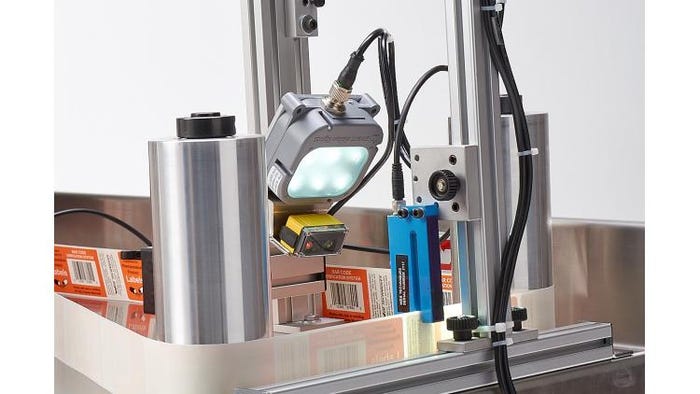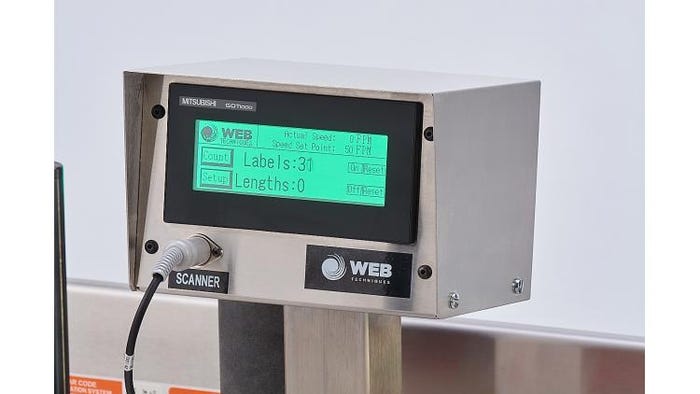Combine rewinding with vision to ensure pharma labeling accuracy
April 26, 2017

According to the FDA, 11% of packaging and labeling-related pharmaceutical recalls in 2014 were caused by labeling mix-ups. Many of these problems can be traced to the traditional manual approach of inspecting labels, which relies upon operators to detect errors in labels as dozens of them flash by every second.
Developers of rewind systems used to count and prepare labels for application to drug packages are moving to address this challenge by upgrading their products with machine vision so that they can automatically inspect every label to make sure it has a readable and correct bar code. Often, these machine vision systems check the label artwork, text, and other factors. The cost of machine vision equipment has fallen to the point that this type of inspection equipment can quickly pay for itself in avoided recalls and reduced labor expenses. One example of this new approach is provided by the Web Techniques WT-35 series rewind system offered with the Cognex DataMan 262X ID reader for verifying bar codes or the Cognex In-Sight 2000 machine vision sensor for complete label inspection.
Label inspection challenges
Pharmaceutical manufacturers invest enormous resources into complying with Good Manufacturing Practices (GMPs) that ensure their ability to maintain high levels of quality in manufacturing drugs. These manufacturers and their suppliers need to also pay considerable attention to labeling of these pharmaceuticals in order to avoid errors that could result in patients taking the wrong medication and suffering serious harm. Labeling issues can also result in enormous financial costs such as those required for product recalls and paying fines as well as damage to the manufacturer’s image and reputation.
To address these challenges, pharmaceutical manufacturers and label converters typically maintain close control over labels, often storing them in a locked cage and releasing only the exact number of labels needed to complete a specific production run. The labels are typically produced in economical large batches so they need to be converted to the smaller batches need for specific production runs. This approach minimizes the chance that leftover labels might accidentally be used on the wrong product. This conversion process normally includes counting out the exact number of labels needed for the production run and inspecting each label to be sure it is correct and has a readable, validated bar code.
The Web Techniques WT-35 bi-directional rewind system quickly and accurately counts and rewinds large master rolls into rolls of a predetermined count or length in either direction. The bi-directional machine saves time by providing the capability of winding the roll right back into the original copy position. The system automatically overspeeds the motor in order to expedite the process of rewinding smaller diameter cores, providing higher speed in the common application of rewinding small rolls from bigger rolls. Web Techniques has produced tabletop roll label rewinding and inspecting machines since 1976. The company produces four different models of rewind machines as well as optical splice and label error detectors, clear label counters, slitting attachments, constant web speed controls, and ink jet imprinting systems.

Above: Closeup of ID reader on rewind system. Image courtesy of Cognex.
Limitations of manual inspection
Pharmaceutical manufacturers and converters typically rely upon manual visual inspection at one or more stages during the label converting process. Each roll is unwound on the rewind system, which is typically equipped with sensors to count labels, check for missing and torn labels, and in some cases validate bar codes. Rewind systems are frequently equipped with a strobe light to provide the machine operator with the opportunity to view each label, if only for a tiny fraction of a second, to verify its correctness. The problem with this approach is that rewinders operate at such a high rate of speed that operators have a great deal of difficulty detecting even major errors such as a completely different label. A typical rewinder operates in the area of 300 feet per minute, which means that for a typical pharmaceutical label 1.5 inches long, the operator must inspect 40 labels per second and has only about 20 milliseconds to process each label. The result is that the operator is normally only able to detect gross errors that are repeated over many labels. The operator may even miss repeated errors if he or she is tired or distracted.
“When I purchased this company two years ago, my top priority was redesigning its equipment to take advantage of the latest technological advances,” said Todd Hickman, President of Web Techniques. “We upgraded to programmable logic controllers (PLCs), variable frequency drives, and touch screen controls to create rewind systems that allow for new technologies to be integrated seamlessly. As an example, we used to offer redline lasers for bar code validation, but these systems were only capable of validating 1D bar codes. They were not able to validate 2D bar codes or determine whether or not the artwork is correct. They were also limited in throughput and required maintenance due to moving mechanical components. With the increase in capabilities and reduction in price and size of vision systems that has occurred over the last few years, I felt that the time had come to incorporate machine vision across all our products. We selected Cognex as our machine vision supplier of choice because Cognex was already a well-respected and preferred supplier to the pharmaceutical industry whose units are trusted with critical inspection processes. Another benefit of working with Cognex is that the company’s global footprint enables them to help us service pharmaceutical companies’ plants around the world.”

Human machine interface (HMI) of rewind system. Image courtesy of Cognex.
Integrating rewind systems with machine vision
Web Techniques has already begun integrating Cognex image-based ID readers and vision sensors into its products. These include DataMan 262X fixed-mount image-based ID readers, which offer the ability to process the complete image in order to identify codes that cannot be read with redline scanners such as 2D bar codes. These bar code scanners can acquire and decode up to 45 images per second using a high-speed, powerful platform that runs the latest Cognex algorithms. Cognex’s 1DMax decodes damaged or poorly printed 1-D bar codes as small as 0.8 pixels per module (PPM). And its 2DMax provides reliable 2-D code reading independent of code quality, printing method, or the surface that the codes are marked on and can locate and read 2-D codes that exhibit significant damage to or complete elimination of the finder pattern, clocking pattern, or quiet zone.
Web Techniques also integrates Cognex In-Sight 2000 vision sensors into its products to provide the capability to not only read bar codes but also to validate the identity of the label including artwork, text, and blemishes. In-Sight 2000 vision sensors are designed for quickly and easily addressing error-proofing applications. The operator can set up the inspection of a new label simply by acquiring an image of the new label and making a few adjustments such as how closely the image must match the pattern. The simplicity of operation is increased by the integration of a lens and LED ring light that produces even, diffuse illumination across the entire image. Lenses and a variety of light colors can be easily swapped out as needed to meet application requirements. Together with the In-Sight Explorer EasyBuilder interface, which provides a fast, step-by-step application setup, the In-Sight 2000 series allows even novice users to achieve extremely reliable inspection performance in nearly any production environment.
To date, Web Techniques has delivered many converting systems with ID readers for bar code validation and a few with vision sensors for validation of the entire label. “The new vision systems are simple and fast to set up and have enabled the pharmaceutical companies and label printers that use them to eliminate the potential for shipping a product with the wrong label while at the same time reducing labor costs,” Hickman said. “The image-based ID reader and vision sensors have also eliminated problems experienced in the past with redline lasers such as excessive no-reads and inability to keep up with production speeds. The Cognex ID readers and vision sensors are also quite easy to integrate with the PLCs that operate Web Technique’s rewind machines. The ID readers and vision sensors support the Ethernet/IP protocol so they can easily be controlled by the PLC. All in all, the integration of machine vision into rewind systems has the potential to eliminate the potential for injuries and fines associated with incorrect labeling while also reducing labor expenses.”
Bethany Freedman is the Marketing Programs Manager for Cognex Corp. For more details, dial 1-877-COGNEX1 (1-877-264-6391), e-mail [email protected], or visit http://www.cognex.com
**************************************
User-centered design will be one of the major themes at the upcoming Medical Design & Manufacturing (MD&M) East 2017 conference in June. Check out these sessions and more:
To Err is Human, But How Do You Prevent It? Speaker: Michael Wiklund, General Manager, Human Factors Engineering, UL LLC, Wiklund R&D
Panel: What Does Usability Mean Today for Medical Device Engineers? Moderator: Stephen Wilcox, Principal, Design Science; Panelists: Daniel Kosoy, MD, Partner, Athenian Venture Partners; Jim Lebret, MD, Physician, New York University School of Medicine; and David Brick, MD, FAAP, FACC, Clinical Associate Professor, New York University Medical Center
How Usability Research and Engineering are Changing Medical Device Development Speaker: Philip Remedios, Principal, Director of Design & Development, BlackHägen Design
New Tools for Obtaining Better Data from Contextual Inquiry Speaker:Stephen Wilcox, Principal, Design Science
About the Author(s)
You May Also Like


